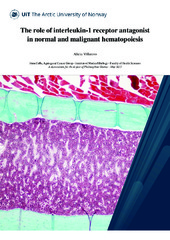The role of interleukin-1 receptor antagonist in normal and malignant hematopoiesis
Permanent link
https://hdl.handle.net/10037/26329Date
2022-09-08Type
Doctoral thesisDoktorgradsavhandling
Author
Villatoro, AliciaAbstract
Interleukin-1β (IL-1β) is a pleiotropic inflammatory cytokine that exerts multiple roles in both physiological and pathological conditions. Enhanced IL-1β signaling drives hematopoietic stem cell (HSC) differentiation into the myeloid lineage and is actively involved in the development and progression of hematological malignancies, including deadly acute myeloid leukemia (AML). Inhibition of IL-1β stands out as a promising therapeutic tool to treat these diseases. In the clinic, several IL-1β-blocking drugs have been FDA-approved and are used efficiently to treat autoinflammatory and autoimmune diseases, including recombinant IL-1 receptor antagonist (IL-1RN, anakinra), soluble receptors, antibodies and IL-1 traps, among others. IL-1RN competitively binds to IL-1 receptor, blocking IL-1α and IL-1β signaling. Despite the contributing role of IL-1β to hematological diseases, little is known about the endogenous IL-1 natural repressor in healthy and malignant hematopoiesis. Here, we found that low IL-1RN is a prognostic marker in AML, associated with lower survival in patients. Low IL-1RN is frequent in AML patients, particularly in those with lower maturation/differentiation profiles as defined by the French-American-British classification (M0-M3). Boost of IL-1RN using anakinra treatment in vivo reduced the leukemic output in AML xenografts, indicating therapeutic potential. IL-1β inhibition with the human monoclonal antibody canakinumab confirmed the therapeutic potential of IL-1β blockade against AML in xenografts. Under steady-state conditions, IL-1rn represses myelopoiesis and enables B cell development given that in vivo genetic deletion of IL-1rn induced HSC differentiation into the myeloid lineage and hampered lymphoid lineage development in mice. This is mediated by IL-1β signaling via, at least in part, activation of NF-κB transcription factor activity. We further found low IL-1rn in an experimental model of pre-leukemic myelopoiesis driven by the oncogene NRAS-G12D. Loss of IL-1β repression through IL-1rn genetic deletion promoted NRAS-G12D – driven myeloproliferation, with participation of both the bone marrow hematopoietic and stromal compartments. Conversely, treatment with anakinra protected against NRAS-G12D – driven pre-leukemic myelopoiesis and improved disease progression.
Taken together, our findings uncover that HSC differentiation is controlled by balanced IL-1β/IL-1rn levels under steady-state and IL-1rn represses excessive myeloproliferation and enables balanced B cell development under healthy conditions. Further, deregulation of IL-1RN leads to loss of repression of IL-1β and may underlie pre-leukemic lesion pathogenesis and AML progression. We further provide a new rationale for IL-1β blockade therapeutic potential in AML and a new means through administration of anakinra.
Has part(s)
Paper I: Arranz, L., Arriero, M.D.M. & Villatoro, A. (2017). Interleukin-1β as emerging therapeutic target in hematological malignancies and potentially in their complications. Blood Reviews, 31, 306-317. Also available in Munin at https://hdl.handle.net/10037/13324.
Paper II: Villatoro A., Cuminetti V., Bernal A., Cossío I., Rubio A., Benguría A., Torroja C., Ferré M., Konieczny J., You X., Utnes P., Tello A., Vázquez E., Fenton C.G., Paulssen R.H., Zhang J., Sánchez-Cabo F., Dopazo A., Vik A., Anderssen E., Hidalgo A. and Arranz L. Endogenous IL-1 receptor antagonist represses healthy and malignant myeloproliferation. (Submitted manuscript).
Publisher
UiT The Arctic University of NorwayUiT Norges arktiske universitet
Metadata
Show full item recordCollections
Copyright 2022 The Author(s)
The following license file are associated with this item:


 English
English norsk
norsk
